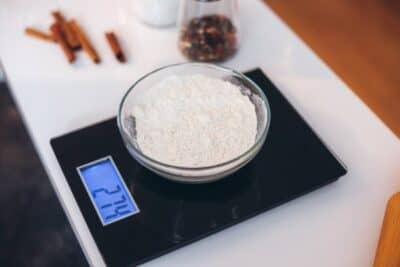
As a rule, a dry cup is usually equivalent to 6.8 US dry ounces. A cup with an estimating scale that demonstrates the estimations in liquid ounces is utilized to quantify fluid things, so an individual knows how much fluid is polished off. Culinary specialists use various cups for dry and liquid fractions in baking and cooking.
Is one fl oz the same as 1 oz?
A liquid ounce is utilized to estimate liquids, though an ounce is used to analyze a vital substance. A liquid ounce is addressed by fl oz, though an ounce is addressed by oz. The liquid ounce estimates the volume involved in a fluid.
How do I measure dry ounces?
We know how many dry ounces are in a cup; now, let’s look at how to measure dry ounces.
The scene in the US is this: If a dry fixing is recorded in ounces, it’s a unit of weight and should be estimated on a scale. On the off chance that a wet fixing is recorded in ounces, it’s liquid ounces and should be calculated in a wet estimating cup.
How do you convert dry ounces into cups?
Ounces can be an estimating unit for one or another weight or volume, even though plans typically determine “liquid” or “fl” ounces while alluding to ounces as estimations of volume.
Changing cups over. to Ounces Dry
Flour (plain or self-rising): 1 cup = 4.41 ounces.
Oats: 1 cup = 3.6 ounces.
Granulated sugar: 1 cup = 7.09 ounces.
How to Use Dry Measuring Cups
Dry ingredients like flour and sugar are best estimated in dry measuring cups. There are numerous techniques for filling a dry measuring cup: filtering, spooning, scooping, and scooping. The strategy by which you fill a dry estimating cup can genuinely adjust the mass of the fixing you’re estimating.
- To get it done, have your dry fixings in a wide-mouthed pack or container. Dunk your dry estimating cup into the holder and lift it out, allowing the dry fixing to flood from the top.
- Utilize a straight edge, similar to the edge of a margarine blade, a chopstick, or a seat scrubber, to even out the highest point of the cup.
- An appropriately estimated dry cup of flour ought to have a level face that is level with the edge of the cup.
Cups to dry ounces
To change over between cups and dry ounces (oz), it’s vital to note that a cup is a unit of volume and the dry ounce (oz) is a unit of weight. This implies that making a change requires an additional element—a substance thickness figure. As an exceptionally unrefined model, a cup loaded with sugar will weigh less than a cup packed with olive oil since olive oil is a denser substance.
Here I have given a rundown of fixings to look over. Nonetheless, kindly know that these are approximations; various brands of fixings will differ to a degree. This implies that the outcomes you get will be assessments.
| Ingredients | 1 Cup | Grams |
| Flour | 4.41 oz | 529 g |
| Butter | 8 oz | 959 g |
| Honey | 11.85 oz | 1420 g |
| Margarine | 8.1 oz | 973 g |
| Oats | 3.6 oz | 432 g |
| Brown Sugar | 7.05 oz | 850 g |
| Granulated Sugar | 7.09 oz | 849 g |
Different cup sizes
The invention of the cup dates back thousands of years. It has been in use since the early Bronze Ages. It’s a crucial component of eating and drinking. Cups were used for drinking as well as eating back in the day.
People realized when the world grew and commerce became more global in the late 19th century that there needed to be a standard size for everything so that there would be fewer obstacles in business and large-scale production.
There are two primary sizes of cups in use around the world.
The first is the standard cup size in the United States, and the second is the standard cup size in the United Kingdom. Both are somewhat different in size and volume, but they make a tremendous impact on a recipe when used in baking and cooking.
Before the 19th century, cup sizes were undefined. It had no international standard or scale. People from all over the world used to produce them in their own sizes because global trade was not yet at its pinnacle, and people weren’t aware of the need for standardization.
Cup sizes in the United States
Different companies in the United States use different sizes of cups for various purposes. The following are the specifics, including the names and sizes used in North America.
Cup size in the United Kingdom
In the United Kingdom, a cup equals 10 imperial fl oz or 12 imperial pints. Instead of using the SI unit system to measure a cup, other Commonwealth countries utilize the metric system. A cup of 250 milliliters is used in Australia, Canada, and New Zealand.
How many dry ounces are in a cup of sugar?
The density of sugar varies depending on the type. As a result, the number of ounces in one cup fluctuates. The following table shows how to calculate how many dry ounces are in a cup with various sugar densities:
- Sugar granules
The most common type of sugar used in baking is white or regular sugar. Sucrose is a disaccharide composed of glucose and fructose. The dry ounces in a cup of granulated sugar are listed below.
0.2 kilograms = 1 cup = 7.1 oz.
- Icing sugar
It’s powdered sugar made from granulated or caster sugar that can be made at home. They can be blended or processed in a food processor. The dry ounces in a cup of icing sugar are listed below.
0.125 kilograms = 1 cup = 4.4 oz.
- Raw sugar
Because it contains fibers and molds, raw sugar is considered nutrient-dense. After the molasses and refined sugar have been removed from the sugarcane, these are what’s left. Raw sugar has no specific health benefits because it is less processed. The dry ounces in a cup of raw sugar are listed below.
- Granulated sugar
Brown sugar is sucrose sugar with a higher molasses content than white sugar, giving it a distinctive brown hue.
Brown sugar is white sugar with different proportions of added molasses, which distinguishes it from raw sugar. Raw sugar is the end product of a refining process that skips the final step of refinement.
The dry ounces in a cup of granulated sugar are listed below.
0.2 kilograms = 1 cup = 7.05 oz.
Conclusion
To be more specific, how many dry ounces are in a cup? Its ingredients are listed in ounces, which is a weight unit that should be calculated on a scale. If a wet ingredient is listed in ounces, it is liquid ounces, which should be estimated using a wet estimating cup. Water, stock, milk, cream, nectar, or oil would all be reported in liquid ounces, whereas chocolate chips, oats, flour, pasta, and rice would all be recorded in ounces (weight) (volume).
